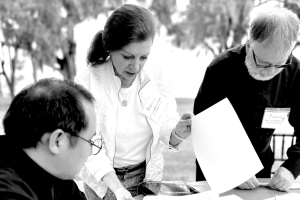Communication is the key to building an active, engaged parish. And even though some of the steps to good communication may seem obvious, it is surprising how many parishes don’t follow them. How many of these best practices are at work in your parish?
Communicate the right message
Successful parishes communicate welcome, not judgment. “We lead with the best of Catholic tradition,” says Patty Spear, pastoral associate for youth and young adult ministry at St. Joseph Parish in Buffalo. “We meet people at the door, making sure we’re welcoming and open.”
Kristin Costanza, communications director at Church of the Nativity in Baltimore, adds that it is important to ask, “What is your community thinking?” You can’t know how—or what—to communicate until you’ve listened to your parishioners. “We try to know as many (people) as we can and know their stories,” says Spear of the teens who come into faith formation programs at St. Joseph.
Parishes also need to remember that less is more when it comes to communication. Matthew Warner, who runs a blog and communications business called Flocknote, mostly for Protestant churches, warns that worshippers will put an overstuffed bulletin aside and not read it. Parishes will end up communicating nothing if they try to say too much, Warner says.
Use the right method
Yes, your parish does need an attractive, modern, and easy-to-navigate website if it hopes to communicate with both current and potential parishioners. Don’t let it go stale, either—no “recent goings-on” from a year ago. “Using the online presence is important,” says Spear. “Ours isn’t perfect but it looks nice.”
The Barna Group, which does research for churches, nonprofits, and businesses, recently released a study on practicing millennials (18-30-year-olds) finding that 56 percent check out a parish’s website before visiting the church. “It may be that for millennials, checking out a faith community online, from a safe distance, is a prerequisite for the commitment of showing up in person,” write the study’s authors.
In addition to a good website, parishes should use an up-to-date email service. Warner started Flocknotes primarily for this purpose. Professional email means the right recipients get the right messages, i.e., choir members get the choir updates, not the St. Vincent de Paul announcements. These emails have the appropriate “unsubscribe” capabilities and are surprisingly inexpensive. A number of cost-effective services are available: VerticalResponse is free up to 10,000 emails per month and MailChimp is free for up to 2,000 subscribers and 12,000 emails a month, just to name two examples.
Reach the right audience
Every church has a vocal minority who are already signed up and actively involved.
Parishes depend on these people, but messaging shouldn’t be just for them—it is vital to preach to the people who aren’t already members of the choir.
“Don’t just say things that are interesting to you,” Warner writes in his Flocknotes blog. “Say things that are interesting to [the unengaged] and in a way that they will understand and be intrigued.”
That often means going out into the congregation and making a point to talk one-on-one with the people who you don’t already know. “Nothing beats the personal contact,” says Deacon Jesus Espinoza of St. Elizabeth Ann Seton Parish in Aloha, Oregon. When someone attends Mass, he suggests approaching them with an offer of an activity to help out with or an event to attend. And if you can’t do it in person, make sure that when someone visits the website they will be intrigued to sign up for email reflections, updates on holy day celebrations, or more information about their favorite ministry.
Finally, Church of the Nativity’s Costanza reminds parishes to begin by knowing they will make mistakes while communicating, whether they are speaking or twittering. That’s part of the deal. Don’t let it scare you into not trying—consider making mistakes as proof that you’re actively communicating.
This is a web-only sidebar that accompanies “Five habits for highly effective parishes” which appeared in the March 2014 issue of U.S. Catholic (Vol. 79, No. 3, pages 12-17).












Add comment